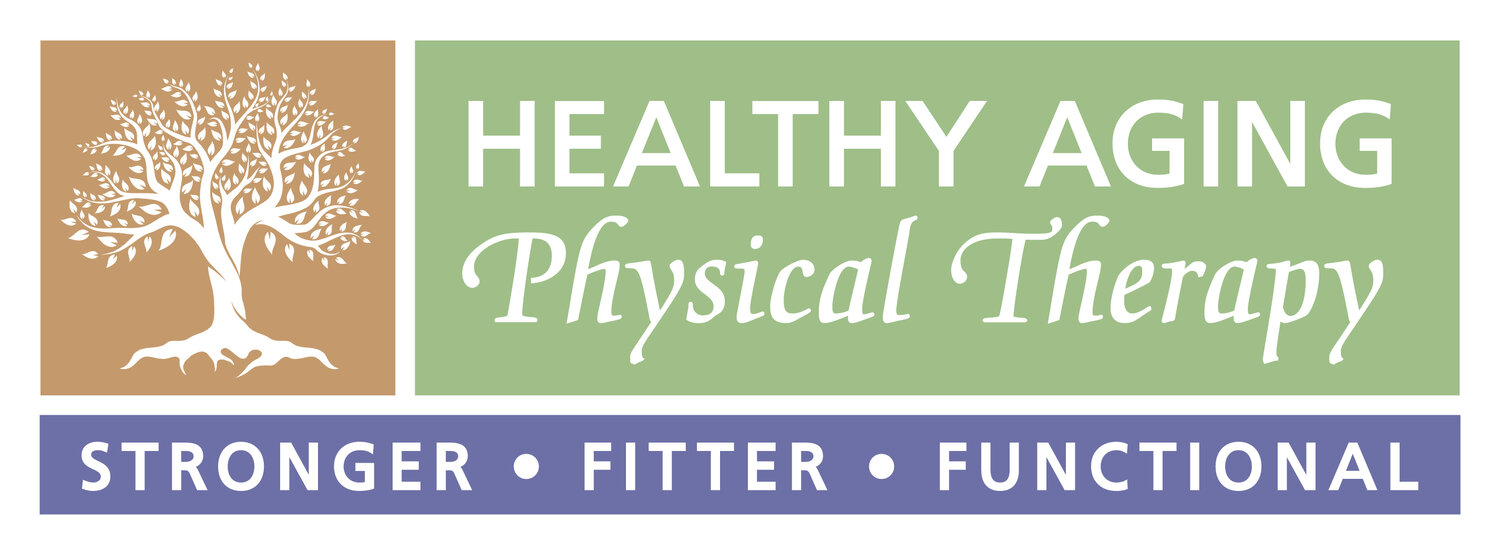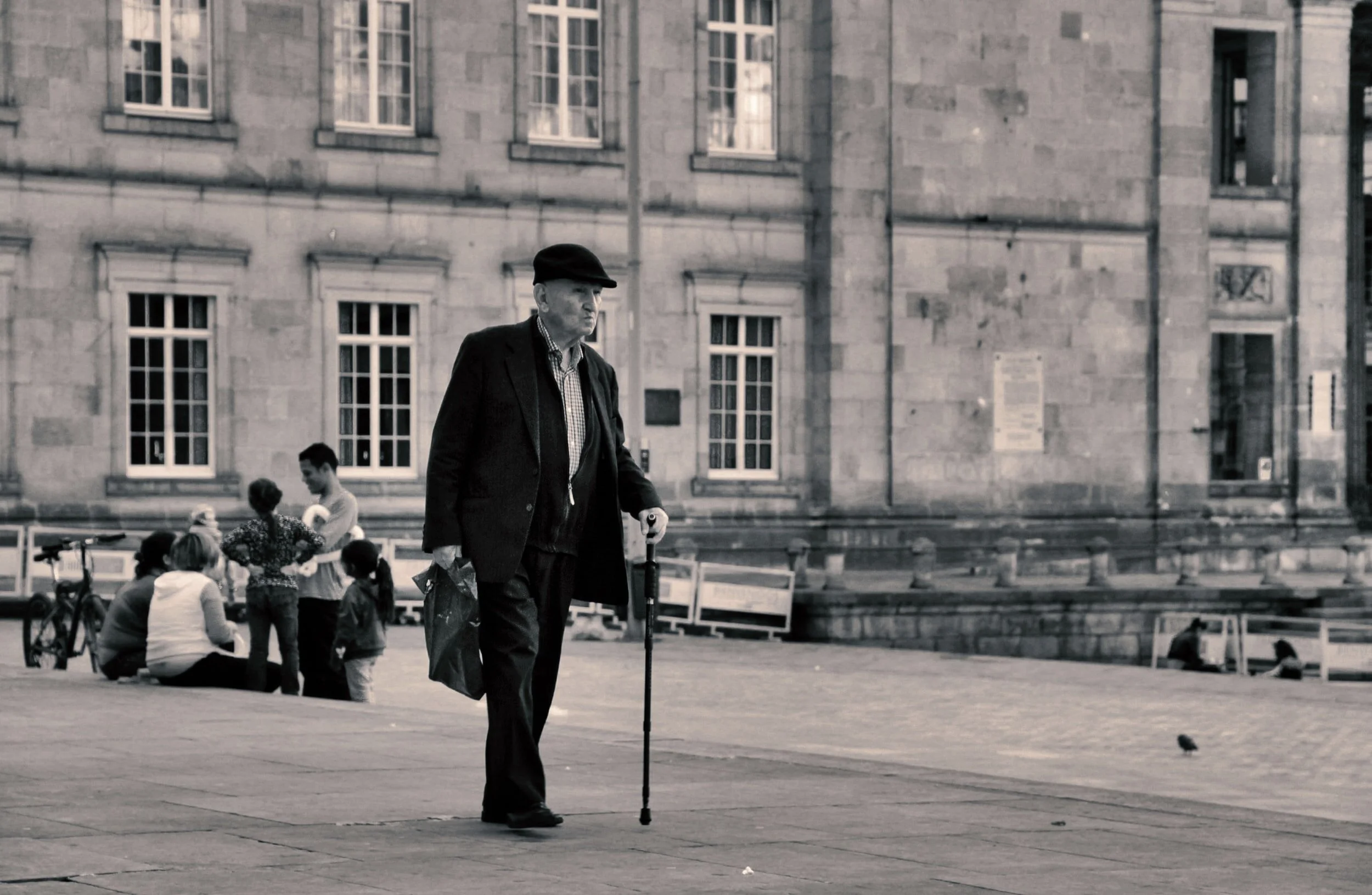Should I use a Cane or a Walker?
The answer is...it depends! (Shocking, right?)
As a Geriatric Physical Therapist, I spend oodles of time talking about assistive devices. Whether it’s working to wean off of one, or trying to convince my patient to use one, my day-to-day includes much talk of canes, walkers, wheelchairs and the like. But like most things in PT-world, the who-gets-what assistive device conversation is never black and white. That said, here are a few things I think about when deciding which assistive device to recommend.
Should I walk with a Cane?
These are your run of the mill straight stick supports like the guy is using above. They can have flat tops or curved; sometimes people buy fancy tripods to help them stand up or ice picks to add to the bottom to use in the winter. They come in all shapes and sizes, but have one thing in common - they will not stop you from falling if your legs give out. So, my first factor in determining whether to recommend a cane is strength. Basically, if you’re going to use a cane, you need to have enough strength to walk at least the distance you’ll be using it to walk (household or community) a couple of times in a row securely. The second factor I consider is balance. While a cane is great for folks who have minor balance impairments, you really need to have adequate reactive responses (the ability to catch your balance if you do start to fall) to make walking with a cane safe. The last thing I generally think about is coordination. Some people, (no judgement here..) are just not ‘cane-people’. Instead of helping, it becomes a hindrance. If the idea of using a cane seems overwhelming, requires a lot of focus or becomes another item to trip over, it probably isn’t the device for you. In fact, these are the folks I actually tend to focus towards without a device.
Does using a cane help with pain?
I tend to use canes for my folks that have pain. A cane is a GREAT way to reduce load on a painful joint - whether temporarily or ongoing as part of a pain management plan. Another pro for canes - it helps people walk with a more natural gait pattern (good for brain = good for gait). But there’s a catch - if you use a cane on the wrong side (the side CLOSEST to the painful side), you actually increase the load and as a result, the pain. So, if you’ve got a painful right knee, the cane needs to go on the left so when you step onto that side, the cane is there to support it. I won’t go into much detail about the other cane options (large-based or small-based quad canes), because quite frankly, I don’t like them. It is hard for people to remember which way to use them (flat side goes toward you FYI), they get under-foot quite easily, and generally slow people down. Yes, they have their purpose for a small group of folks (like people with hemiplegia after a stroke) but for our general purposes today, I’ll leave them in them out of the discussion.
Should I walk with a Walker?
Walkers, like people, come in all shapes and sizes, and vary in quality. The old silver one with the wheels in the front and legs in the back is called a Rolling Walker. Four legs without wheels is a Standard Walker. (To save some time and energy, the only time a standard walker is going to the the ‘right answer’ is if you aren’t allowed to put full weight on your leg, or if you are missing a leg. Case Closed.) Despite the fact that we’ve developed crazy things like the INTERNET in the last hundred years, the design of these two basics actually haven’t changed much, if at all. These are the kinds of walkers you’ll come home from the hospital with if you’ve had a joint replacement or experience a fall and fracture. While the rolling walker has it’s time and place, and is certainly the safest option *in-home* for many people, it is not my favorite device. Using a rolling walker a) limits your speed (bad for brain = bad for gait), b) limits your trunk rotation and arm swing (again bad for brain = bad for gait) and c) frequently leads, in my opinion, to increased isolation because people often either don’t want to be seen by their neighbors and friends with a walker, or just find the darn thing cumbersome. I put *asterisks* around *in-home,* because my biggest walker pet-peeve is they are HORRIBLE for walking on most suburban streets and sidewalks. While they may work well l if you live in a brand new town with perfectly manicured roadways, where I live, between tree-roots and frost heaves, most areas I gait-train with patients are basically a head-over-heels situation waiting to happen. Watching a patient try to navigate uneven terrain with a rolling walker is not my favorite experience. Walkers don’t work on grass, they don’t work on sand, and in reality, they don’t work too well on sidewalks.
What is the best Walker to buy?
Enter the Rollator. Rollators get a bad rap because they move fast and because the brakes get loose, but I actually prefer to wean a patient onto a rollator when I can. Rollators, with their four wheels + hand brakes and a built-in chair, give a person an option for life outside of their home (in my humble opinion). Using a rollator, for most people, is more intuitive than a walker; it actually turns in a circle and makes turning corners way easier, it is smoother over uneven sidewalks, can actually go over grass - and my favorite, allows you the freedom to walk further because you have an option to sit and take a break when you need to! Rollators make great choice for someone who may be limited by balance, endurance, cardiopulmonary impairments or back pain, but who still would like to be able get out and about in their communities. Quick note about rollator quality: while the general ‘got it for free from a neighbor’ rollator may not be the best, when a patient can afford it, I usually recommend a sturdier model called the Nitro. It is heavier, but stronger, more secure and is like the SUV of rollators. (Nitro Walker)
Still wondering if a Cane or a Walker or Nothing at All is the right thing for you? Ask a PT:)
We are movement experts; our job is to help you find the safest way to navigate your environment while at the same time, giving you the maximum independence. For some, this may mean weaning off an assistive device; for others, it may means encouraging you to use one. The Cane Vs. Walker Showdown is rarely black and white. What may work in your home may not be what is best for use in the community. You may be able to use a Cane or Nothing at All during the day, but a Walker may be best at night. See, like I said…It Depends:)
About the author:
Dr. Katie Wadland, PT, DPT is the Owner and Primary Physical Therapist at Healthy Aging Physical Therapy. Healthy Aging Physical Therapy offers in-home Physical Therapy for older adults living in Melrose, Medford, Arlington, Stoneham, Winchester, Reading, Woburn, Wakefield and Lynnfield, Massachusetts. She is licensed to practice Physical Therapy in the State of Massachusetts (License #18193). She has over fourteen years of experience working with older adults with musculoskeletal and neurological impairments and advanced training in the care of people with Parkinson’s Disease, Spinal Cord Injury and Stroke.





